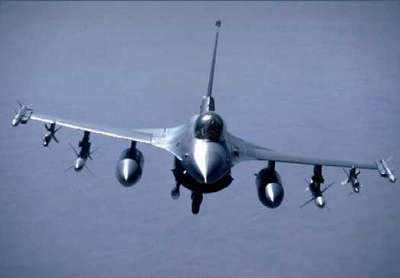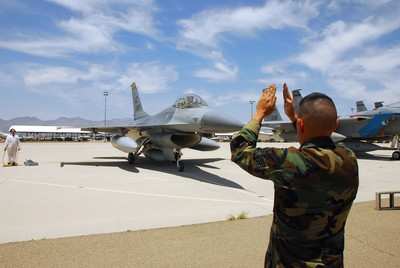Surpasses 6,000 Hours At Controls Of An F-16
An Air Force Reserve pilot deployed from Balad Air Base, Iraq
broke his own world record for hours spent flying the F-16 Fighting
Falcon when he surpassed the 6,000-hour milestone on Friday.

Lt. Col. Michael Brill, a pilot assigned to 421st Expeditionary
Fighter Squadron, has been breaking world aviation records since
1993, when he surpassed the world's first pilot to fly 3,000 hours
in the F-16. In August 1998, he became the first pilot to fly 4,000
hours and, in November 2002, he was the first pilot to attain 5,000
hours.
"The sustained effort required to spend 6,000 hours flying the
F-16 is phenomenal," said Brig. Gen. Burton M. Field, commander of
332nd Air Expeditionary Wing, of which the 421st EFS is a part.
"Six thousand hours equates to 250 days in the cockpit -- not
counting all the time in ground ops before and after the flight.
That is an incredible amount of time in a high-G [force],
high-speed, high-stress arena.
"Flying fighters is mentally and physically challenging. The
environment, threat, systems, weapons and the mission set are
constantly changing and require a disciplined program of study and
practice to remain on the cutting edge," said the general, who
graduated with the colonel in 1979 from the Air Force Academy. The
two attended F-16 training together at Hill Air Force Base, Utah,
in 1980.
 Despite the challenges
of flying the F-16 almost constantly since 1980, Brill said he
wouldn't have it any other way. "I love to fly. I don't remember
ever wanting to do anything else. There is a communication between
me and the machine. Flying an airplane is like being on a roller
coaster that you can steer," said the colonel, who grew up on
various Marine Corps bases, but calls Virginia home.
Despite the challenges
of flying the F-16 almost constantly since 1980, Brill said he
wouldn't have it any other way. "I love to fly. I don't remember
ever wanting to do anything else. There is a communication between
me and the machine. Flying an airplane is like being on a roller
coaster that you can steer," said the colonel, who grew up on
various Marine Corps bases, but calls Virginia home.
Brill, who is deployed from Hill Air Force Base, likened the
evolution of the missions F-16 pilots fly and the development of
precision-guided weaponry to the strides that have been made with
computer technology over recent decades.
"It's been a constant challenge -- nothing has stayed the same,"
he said. "The development of the aircraft and missions requires
constant emphasis and effort to go to the books. In aviation, the
precision weapons that we use now compared to those in the past are
more of a revolution rather than an evolution."
Brill has personally experienced these changes while flying
nearly 225 combat hours and more than 65 combat sorties. His combat
experience includes three tours in support of Operation Northern
Watch, two in support of Operation Southern Watch, two in support
of Operation Iraqi Freedom, and one in support of Operation
Enduring Freedom.
In addition, he led the first F-16 strike into Afghanistan
following September 11, 2001, a 10-hour mission he described as an
"eye-opening experience." The more recent combat missions he has
flown since arriving in Iraq in March have been a lot "quieter,"
because fewer munitions have needed to be dropped -- an indication
that the global war on terrorism is being won, the colonel
said.
Many of the missions flown by pilots in Iraq are reconnaissance
missions, in which information is gathered using high-tech cameras
to identify potential ground threats.
"Our primary mission [as flyers providing close-air support for
ground units] is to make noise," he explained. "We are up there to
let the bad guys know what we're capable of and to keep them
hunkered down. This allows the [ground personnel] to work to
establish good relationships with the people who are helping us.
The impact of the air power is knowing that the airplane overhead
gives people on the ground an umbrella of safety that is basically
irreplaceable."
Brill's active-duty assignments have taken him to Holloman Air
Force Base, N.M.; Hill Air Force Base;, Nellis Air Force Base,
Nev.; and Kunsan Air Base, South Korea.
In 1990, Brill became an air reserve technician, which basically
is a full-time reservist position. He has been assigned to 419th
Fighter Wing at Hill since then and is chief of the safety
Office.

His status as a deployed reservist is an example of the Air
Force's integration of personnel from all military branches --
active duty, Reserve and Air National Guard.
"The Air Force has been over here in Southwest Asia for 17
years," Field said. "To accomplish our mission, we have needed the
Guard and Reserve every single day of those 17 years. They bring
experience, judgment and maturity to the fight in a variety of
different mission sets and you can't tell them apart from the
active-duty [airmen] by their appearance, dedication, pride or job
performance."
Reserve airmen do not move to new locations at the same three to
four-year frequency that active-duty airmen move; their long-term
presence at a base is another way reservists positively affect Air
Force operations, Brill said.

"We give continuity to active-duty personnel because of our
longevity in a location," he explained. "We help facilitate
programs and provide cradle-to-grave support. We bring a
stabilizing influence to a rapidly changing world; it's the very
nature of total force integration. We are seamlessly integrated
with our active-duty counterparts."
Though Brill is the only person to surpass the 6,000-flying-hour
mark in an F-16, he's already looking to the future. With five
years left until his retirement, he said, he doubts he'll be able
to hit 7,000 flying hours, but he's willing to give it a try.

"If they want to throw that many sorties at me, I'll take them,"
he said. "I never say no when they ask me to fly. I love it."
(Aero-News salutes Air Force 1st Lt. Lisa Spilinek, 332nd
Air Expeditionary Wing Public Affairs Office)
 ANN's Daily Aero-Linx (04.16.24)
ANN's Daily Aero-Linx (04.16.24) Aero-News: Quote of the Day (04.16.24)
Aero-News: Quote of the Day (04.16.24) Airborne 04.10.24: SnF24!, A50 Heritage Reveal, HeliCycle!, Montaer MC-01
Airborne 04.10.24: SnF24!, A50 Heritage Reveal, HeliCycle!, Montaer MC-01 Airborne 04.12.24: SnF24!, G100UL Is Here, Holy Micro, Plane Tags
Airborne 04.12.24: SnF24!, G100UL Is Here, Holy Micro, Plane Tags Airborne-Flight Training 04.17.24: Feds Need Controllers, Spirit Delay, Redbird
Airborne-Flight Training 04.17.24: Feds Need Controllers, Spirit Delay, Redbird







